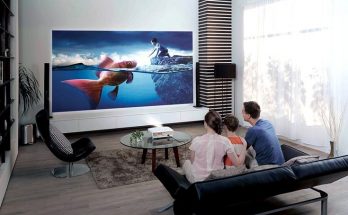When we stare at anything up close, our eyes go inside and make an effort to see clearly. Because projectors are frequently situated at a safe distance, they are less often used than mobile phones and laptops. Therefore, headaches, tension, and eye strain will be less when using projectors than mobile phones and laptops.
When picking between a projector and a television, eye and brain health are important factors to consider. TVs and other screens emit direct blue light, which is harmful to the eyes. The indirect light from a projector, even the indirect blue light, is easier on the eyes. Projectors are the most satisfactory solution for eye and brain health, along with additional safety features that you may learn about below.
Blue light, in particular, should be a top priority for persons who are hooked on screen time. It is emitted by LCD, LED, and all other types of televisions, harmful to our health, especially at night. Headaches, digital eye strain, and neck and back pain are all caused by blue light.
Projectors are an alternative to blue-light-emitting televisions. They also produce blue light, but as you’ll never be staring directly at the light source when viewing, it will not reach your eye and brain directly. Before getting your eyes, the light bounces off another surface (a projector screen or a wall).
The screen size of a projector can quickly provide larger images for individuals seeking eye comfort. Larger displays produce visuals that are wider and more pleasant to look at. As a result, your headaches will be less frequent. Furthermore, projectors use reflected light, which is less obtrusive to your vision and lowers eye strain and other harmful effects of extended viewing. Compared to televisions, projectors provide larger screens, minimize blue light, avoid direct sunlight, and use reflected light, resulting in a far more comfortable viewing experience and fewer headaches.
How to Avoid Headaches Due to Screens
When you have a screen headache, you can deal with the symptoms. However, suppose you can prevent migraines from occurring in the first place. In that case, you’ll be able to avoid (or at least lessen) the agony and suffering that comes with them. Here are some tips for preventing headaches and migraines caused by screen use.
Make changes to the lighting
Eye strain and screen headaches can be caused by the brightness of your monitor or electronic device, as well as the lighting in your environment. Keep the lighting in your home, both natural and artificial, regulated with the display’s brightness to reduce eye strain, which can contribute to screening headaches and migraines. Moreover, think about where you want to put your screen to minimize glare.
Take regular breaks
Staring away from the screen during the workday or while watching television may lessen eye strain and, as a result, reduce the risk of a migraine or screen headache.
Determine the distance
Since screen headaches and migraines are a problem, make sure your display is at least 20 to 25 inches away from your eyes.
Invest in a screen protector
Consider placing an anti-glare screen on your monitor if the glare from your screen is causing you to strain your eyes.
FAQs
Is it true that projectors are healthier than screens?
The projector gives you a lot more versatility while also being safer for your eyes. Projectors lessen the impacts of blue light and direct light while also allowing you to alter the size of the projected image, and newer projectors have intelligent safety mechanisms to prevent unintentional eye harm.
Are projectors capable of making you dizzy?
The most common symptoms are dizziness and nausea, and people’s susceptibility to them varies widely. The effect is amplified by larger screens, which diminish the other visual cues available to your eyes (the rest of the room).
Is it possible that projectors are harmful to your health?
Of course not. The projector displays a picture onto a screen, and users look at the light-reflecting surface. Because a computer screen/display/TV is an active device, it is more likely to cause strain and have an impact on your eyes than a projector.
Is it safe to use a laser projector?
Unless users stare directly into the lens for lengthy periods, there is little risk of retina damage.” “High-powered laser projectors are no more harmful than other lamp-based, high-brightness projection systems,” according to Christie, another laser projector manufacturer.
Conclusion
To sum up, the projector provides significantly greater freedom while also being far safer for viewers’ eyes and brains. Projectors lessen the impacts of blue light and direct light while allowing you to vary the screen size, and modern projectors have intelligent safety features to prevent headaches.
Consider how a new TV or projector will affect your headaches while you’re thinking about buying one. Try a projector to get away from all of the screens in your life.





